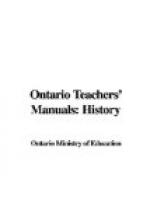1. Who compose
the board of trustees? (In the smaller local bodies,
the names of the members
may be mentioned, as giving a personal
interest in the matter.)
2. How and by whom are they elected?
3. For what period are they elected?
4. How is the board organized for the conduct of business?
5. What powers do they possess?
6. What duties have they to fulfil?
7. How do they raise the money needed for their work?
8. How is the board
rendered continuous? (By electing a successor
to a member who resigns;
by the trustees remaining in office till
their successors are
elected.)
Other governing bodies may be taken up similarly, for example: Municipal Councils (township, county, village, town, or city council), Provincial Legislature, Dominion or Federal Parliament, Imperial Parliament. A suitable time to bring up the topic of how elections are conducted would be when an election for any of the above bodies is in progress. Information on this topic may be found in Canadian Civics, by Jenkins; a fuller account is given in Bourinot’s How Canada is Governed.
Lessons concerning special bodies of municipal and civil servants may be taken; for example, the assessor, tax-collector, policeman, postal employees, firemen, etc. In connection with all of these, the question of taxation is constantly arising. It is suggested that something should be done to put the pupils in the right attitude toward this subject. Many people have an idea that when they pay taxes they are being robbed, because they do not stop to think of what they are getting in return for their money. The chief reason for this seems to be that the taxes are usually paid once or twice a year, while the services rendered are continuous. A good way to proceed is to have the class calculate the value of the services given in return for the taxes. For example, suppose it is found that the yearly cost for each pupil in a certain section is $25.00. Divide this by the number of days (200) a pupil attends school during the year, and the cost each day for each pupil is shown be only 12-1/2 cents, not a very large sum for a community to pay for a child’s education.
Other calculations may be made to show the saving to farmers by spending money in the construction of good roads to make teaming more profitable. For example: In a strip of country served by a road ten miles long, there is room for eighty farms of one hundred acres each, all the produce of which would be hauled on that road. Let us suppose that this produce would amount to 3,000 loads, such as could be hauled on an ordinary country road. The average haul being five miles, two trips a day could be made. At $5.00 a day, the cost of haulage would be $7,500.




